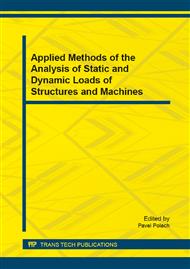[1]
M. Vargas, F. Fojtík, J. Papuga, A. Hodr, Summary of experiments realized within FADOFF project, Technical Report, FAD/12/005, CTU in Prague and VŠB TU Ostrava, Prague, (2012).
Google Scholar
[2]
S. Mielke, Festigkeitsverhalten metallischer Werkstoffe unter zweiachsiger schwingender Beanspruchung mit verschiedenen Spannungszeitverläufen, PhD Thesis, RWTH Aachen, Aachen, (1980).
Google Scholar
[3]
F. Baier, Zeit- und Dauerfestigkeit bei überlagerter statischer und schwingender Zug-Druck- und Torsionbeanspruchung, [PhD Thesis, Universität Stuttgart, Stuttgart, (1970).
Google Scholar
[4]
R. Heidenreich, Schubspannungsintensitätshypothese – Dauerschwingfestigkeit bei mehrachsiger Beanspruchung, Forschungshefte FKM, Heft 105, FKM, Frankfurt am Main – Niederrad, (1983).
Google Scholar
[5]
K. Tanaka, S. Matsuoka, K. Miyazawa, Fatigue Property of JIS-SNCM 8 Steel Under In-Phase Combined Axial Loading and Torsion, Transactions of National Research Institute for Metals 8 (1979) 35-41.
Google Scholar
[6]
T. Rausch, Zum Schwingfestigkeitsverhalten von Gusseisenwerkstoffen unter einachsiger und mehrachsiger Beanspruchung am Beispiel von EN-GJV-450, PhD Thesis, Shaker Verlag, Aachen, (2011).
Google Scholar
[7]
ASTM E 2207-02: Standard Practice for Strain-Controlled Axial-Torsional Fatigue Testing with Thin-Walled Tubular Specimens, ASTM, West Conshohocken, (2002).
DOI: 10.1520/e2207
Google Scholar
[8]
ANSYS® Release 14. 5, Help System, ANSYS Parametric Design Language Guide, ANSYS, Inc., Canonsburg, PA. (2012).
DOI: 10.1016/b978-0-12-811768-2.00022-5
Google Scholar
[9]
M. Pliš, Set of APDL macros for automated preparation of fatigue specimens, Technical Report, FAD/12/002, ver. B, Evektor spol. s r. o., Kunovice, (2013).
Google Scholar


